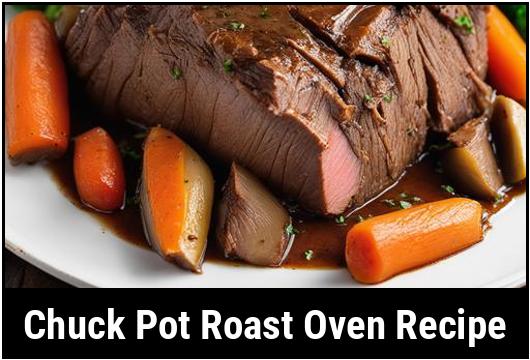
The Ultimate Guide To The Perfect Chuck Pot Roast Oven Recipe
Welcome to the ultimate guide on cooking the perfect chuck pot roast in the oven! In this comprehensive article, we will delve into the food science behind this delectable dish, explore culinary details, provide tips and variations, and walk you through a step-by-step recipe. Whether you are a seasoned chef or a beginner in the kitchen, this guide will equip you with all the knowledge and techniques to create a mouthwatering chuck pot roast. So let’s get started!
Food Science: What Makes Chuck Pot Roast Tender and Flavorful?
Chuck pot roast, also known as "pot roast" or "chuck roast," comes from the shoulder region of the cow. This cut is typically tougher than other cuts of meat due to the abundance of connective tissue. However, with the right cooking method, chuck pot roast can transform into a succulent and tender masterpiece.
The key to achieving tenderness and flavor in chuck pot roast lies in the connective tissue present in the meat. Connective tissue, made up of collagen and elastin, begins tough and chewy. However, when cooked slowly at low temperatures, collagen is converted into gelatin, resulting in rich flavors and a fall-apart texture.
Selecting the Perfect Chuck Pot Roast
Choosing a high-quality chuck pot roast is vital for a successful outcome. When selecting your meat, keep the following pointers in mind:
-
Look for Marbling: Marbling refers to the streaks of fat running through the muscle fibers. Look for even distribution of fat throughout the meat as it adds juiciness and enhances flavor during cooking.
-
Go for Fresh Meat: Opt for fresh chuck pot roast from a reputable butcher or grocery store. Look for meat with a deep red color, indicating freshness.
-
Consider the Weight: Depending on your needs, select a chuck roast that suits your serving requirement. A 3-4 pound roast is typically enough to serve a family of four to six.
Cleaning and Preparing the Chuck Pot Roast
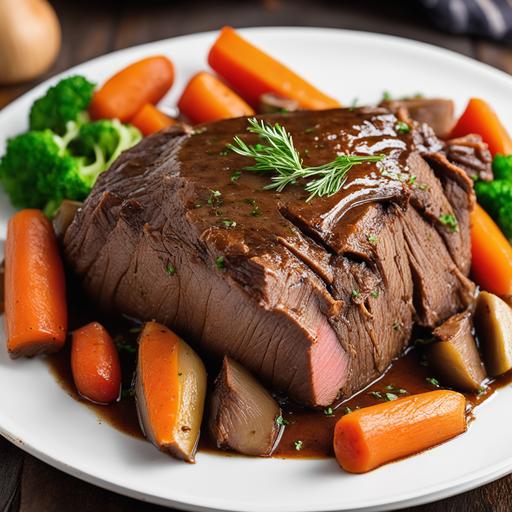
Now that you’ve chosen the perfect chuck pot roast let’s move on to the cleaning and preparation stage.
-
Cleaning: Place the roast on a clean cutting board and pat it dry using paper towels. This helps remove excess moisture that would otherwise hinder browning during cooking.
-
Trimming: Examine the roast for any excessive fat or silver skin. While some fat is desirable for flavor, trim any large pieces that might affect the final result.
-
Seasoning: Generously season the roast with kosher salt and freshly ground black pepper. Feel free to add additional spices and herbs according to your preference. Popular choices include garlic powder, paprika, rosemary, thyme, and onion powder.
Tips for a Flavorful Chuck Pot Roast
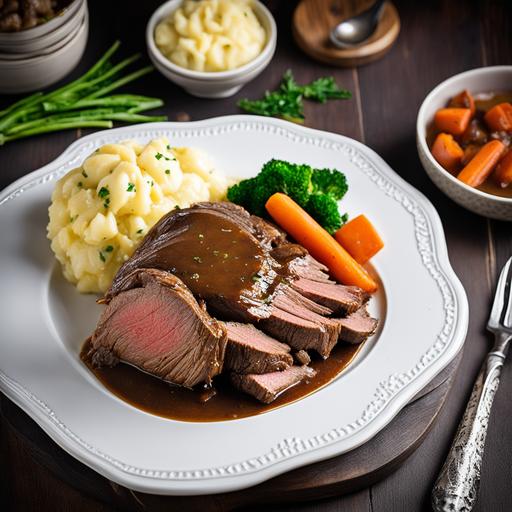
Here are some tried-and-true tips to infuse maximum flavor into your chuck pot roast:
-
Searing: Before putting the roast in the oven, sear it in a hot skillet or Dutch oven. Searing creates a caramelized crust, sealing in the meat’s juices and intensifying the flavors.
-
Layering Flavors: Consider adding aromatic vegetables like onions, celery, and carrots to the cooking vessel. These vegetables impart their flavors into the meat while adding depth to the final dish.
-
Liquids and Broths: Enhance the flavors further by using liquids such as beef broth, red wine, or a combination of both. This adds moisture to the pot, prevents dryness, and creates a flavorful sauce.
Oven Roasting: Achieving Perfect Doneness
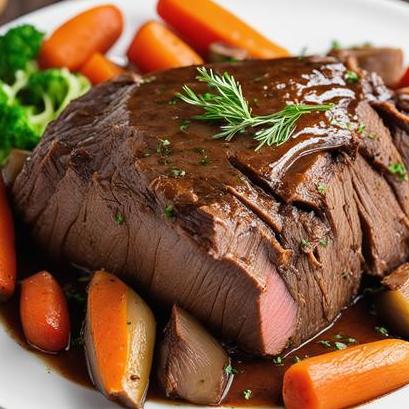
Oven roasting is a popular cooking method for chuck pot roasts. Mastering doneness is crucial for a tender and juicy roast, and these tips will help you achieve the best results:
-
Low and Slow: Set your oven to a low temperature, around 300°F (150°C). Cooking the roast slowly over an extended period ensures tenderization and breakdown of the connective tissues.
-
Use a Meat Thermometer: Invest in a reliable meat thermometer to accurately monitor the roast’s internal temperature. The optimal doneness is achieved when the meat reaches an internal temperature of 195-205°F (90-96°C).
-
Basting: Baste the roast occasionally with the pan juices during cooking. This keeps the meat moist and enhances flavor.
Checking for Doneness
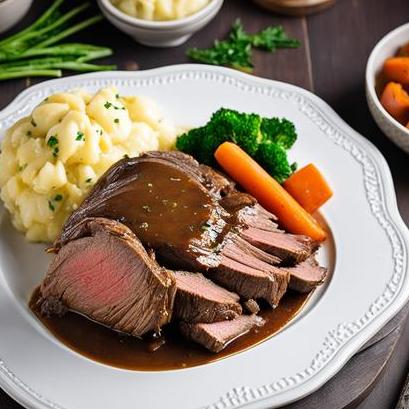
To check if your roast is perfectly cooked, employ the following methods:
-
Probe Test: Insert a meat thermometer into the thickest part of the roast. The meat should register between 195-205°F (90-96°C) for optimal tenderness.
-
Fork Test: Use a fork to gently pry the meat fibers apart. If the meat easily falls apart and is fork-tender, it is ready.
-
Resting: After removing the roast from the oven, allow it to rest for at least 15 minutes. This allows the juices to redistribute, resulting in a more succulent roast.
Overcooking and Undercooking: Troubleshooting Guide
Sometimes, despite your best efforts, a roast might end up overcooked or undercooked. Here are some troubleshooting tips for each scenario:
-
Overcooked Roast: If your roast turns out dry and overcooked, there is still hope! Shred the meat, add some flavorful liquid, and incorporate it into tacos, quesadillas, or stir-fries.
-
Undercooked Roast: In the unfortunate event of an undercooked roast, return it to the oven and continue cooking at a lower temperature until it reaches the desired doneness. It’s always better to err on the side of caution when undercooking since you can easily adjust it afterward.
Chuck Pot Roast Oven Recipe
Now that you have a solid understanding of the science and techniques behind the chuck pot roast, here is a time-tested recipe to put everything into action:
Ingredients:
-
1 (3-4 pound) chuck pot roast
-
Salt and pepper
-
2 tablespoons vegetable oil
-
1 onion, roughly chopped
-
2 carrots, peeled and roughly chopped
-
2 celery stalks, roughly chopped
-
4 cloves garlic, minced
-
2 cups beef broth
-
1 cup red wine (optional)
-
2 sprigs fresh rosemary
-
2 sprigs fresh thyme
Instructions:
-
Preheat your oven to 300°F (150°C).
-
Season the chuck roast generously with salt and pepper on all sides.
-
Heat oil in a Dutch oven or oven-safe skillet over medium-high heat.
-
Sear the roast until browned on all sides, approximately 4 minutes per side.
-
Remove the roast from the skillet and set it aside.
-
In the same skillet, add the onions, carrots, celery, and garlic. Sauté until the vegetables soften and become fragrant, approximately 5 minutes.
-
Deglaze the skillet with red wine (if using) and cook for an additional 2 minutes.
-
Add the beef broth, rosemary, and thyme to the skillet, stirring to combine.
-
Return the seared roast to the skillet, placing it on top of the vegetables.
-
Cover the skillet with a lid and transfer it to the preheated oven.
-
Allow the roast to cook in the oven for 3-4 hours, or until the internal temperature reaches 195-205°F (90-96°C).
-
Baste the roast occasionally with the pan juices throughout the cooking process.
-
Once the roast reaches the desired doneness, remove it from the oven and let it rest for at least 15 minutes.
-
Slice the chuck pot roast against the grain and serve with the vegetables and pan juices.
Variations and Customizations
While the classic chuck pot roast recipe above is incredibly delicious, feel free to experiment with these variations to suit your taste:
-
Asian-inspired: Substitute beef broth with soy sauce and beef stock. Add ginger, star anise, and a dash of sesame oil for an oriental twist.
-
Tex-Mex Twist: Add chopped green chilies, diced tomatoes, cumin, and chili powder to infuse some Mexican flavors into your roast.
-
Herb Infusion: Customize your herbs by swapping rosemary and thyme with oregano, parsley, or even cilantro for a fresh and zesty flavor.
Feel free to unleash your creativity and adapt the recipe to your palate!
Conclusion
Congratulations! You are now armed with all the knowledge and techniques required to execute a perfect chuck pot roast in the oven. From understanding the food science behind the dish to selecting the right cut of meat, preparing, seasoning, and achieving ideal doneness, this comprehensive guide has covered all the essential aspects. Remember to experiment with variations and seasonings to create a signature pot roast that will leave your family and friends in awe. So put on your apron, preheat your oven, and get ready to create a mouthwatering chuck pot roast that will have everyone coming back for seconds!
Sources
FAQS On Chuck Pot Roast Oven Recipe
What Type Of Meat Should I Use For A Chuck Pot Roast Oven Recipe?
A chuck roast is the ideal cut of meat for a pot roast recipe. This cut comes from the shoulder of the cow and is typically a tough cut of meat that requires slow cooking to become tender.
How Long Should I Cook My Chuck Pot Roast In The Oven For?
The cooking time will vary depending on the size of your roast, but on average, a 3-4 pound roast will need to cook for 3-4 hours at 325°F. It is important to check the internal temperature with a meat thermometer, and it should reach 145°F for a medium-rare roast, 160°F for medium, and 170°F for well-done.
How Do I Prepare My Chuck Pot Roast Before Placing It In The Oven?
Start by seasoning your roast with salt, pepper, and any other herbs or spices that you prefer. Next, brown the roast on all sides in a hot skillet with a little bit of oil. This will help to seal in the juices and create a more flavorful crust.
Can I Add Vegetables To My Chuck Pot Roast Oven Recipe?
Yes, adding vegetables like carrots, potatoes, and onions is a great way to infuse more flavor into your roast. Cut the vegetables into large chunks and add them to the bottom of your roasting pan, then place the roast on top and cook as directed.
Should I Cover My Chuck Pot Roast In The Oven?
Yes, covering the roast with foil or a lid during the first half of the cooking time will help to keep it moist and tender. After about 2 hours, remove the foil or lid and let the roast continue to cook uncovered for the remaining time to create a crispy and flavorful exterior.


